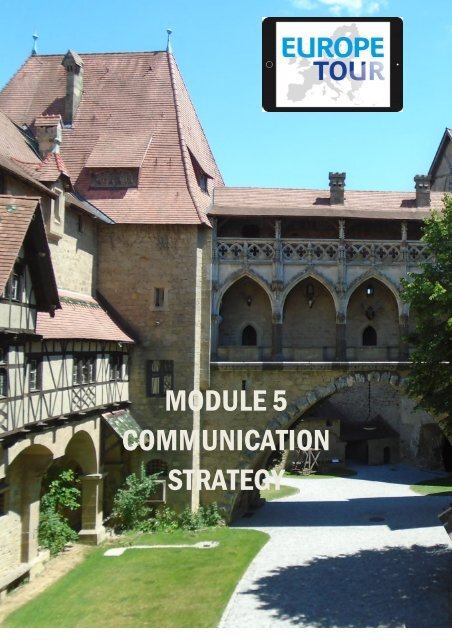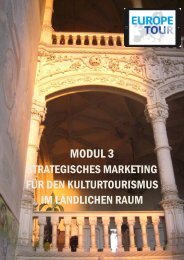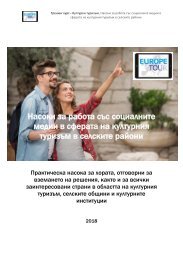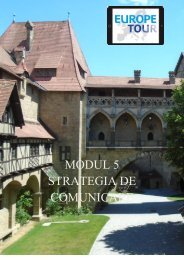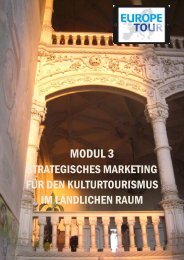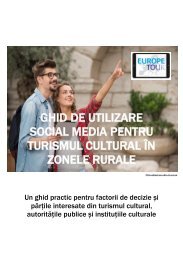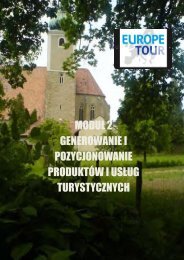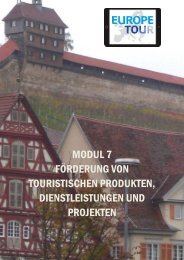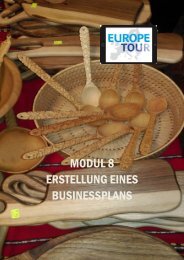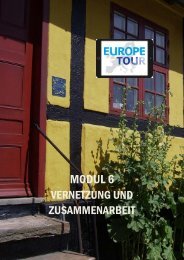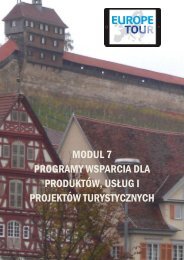M5_Communication_Strategy_v6
Create successful ePaper yourself
Turn your PDF publications into a flip-book with our unique Google optimized e-Paper software.
MODULE 5<br />
COMMUNICATION<br />
STRATEGY
CULTURAL TOURISM TRAINING COURSE<br />
MODULE 5 - COMMUNICATION STRATEGY<br />
This Training Module is part of the Cultural Tourism Training Course which has been developed within<br />
the Erasmus+ Strategic Partnership EUROPETOUR, a European initiative aimed at unlocking the<br />
economic potential of Europe’s outstanding cultural treasures and empowering rural areas to harvest<br />
the potential of cultural tourism.<br />
You can find more information at the homepage: http://www.europetour.tips<br />
Pictures: Wolfgang Eisenreich, Kees Grootswagers, Elena Paschinger.<br />
The EUROPETOUR team would like to express their sincere gratitude to Mrs Jenifer Hawks of Future for<br />
Religious Heritage (Brussels) for proof reading the EUROPTOUR Social Media Guidelines.<br />
This work is licensed under a Creative Commons Attribution-NonCommercial-ShareAlike 4.0 International<br />
License.<br />
You are free to:<br />
share — copy and redistribute the material in any medium or format<br />
adapt — remix, transform, and build upon the material<br />
under the following terms:<br />
Attribution — You must give appropriate credit, provide a link to the license, and indicate if<br />
changes were made. You may do so in any reasonable manner, but not in any way that<br />
suggests the licensor endorses you or your use.<br />
NonCommercial — You may not use the material for commercial purposes.<br />
ShareAlike — If you remix, transform, or build upon the material, you must distribute your<br />
contributions under the same license as the original.<br />
The European Commission support for the production of this publication does not constitute an endorsement of the contents which<br />
reflects the views only of the authors, and the Commission cannot be held responsible for any use which may be made of the<br />
information contained therein.<br />
Project number: 2015-1-DE02-KA202-002325<br />
2
CULTURAL TOURISM TRAINING COURSE<br />
MODULE 5 - COMMUNICATION STRATEGY<br />
Table of contents<br />
Contents of the Module ........................................................................................................................................................................................ 4<br />
Learning objectives .................................................................................................................................................................................................... 4<br />
Psychology of communication ........................................................................................................................................................................... 6<br />
Basics of communication .................................................................................................................................................................................... 13<br />
Corporate Identity .................................................................................................................................................................................................... 17<br />
Sales promotion ........................................................................................................................................................................................................ 22<br />
Public Relations ......................................................................................................................................................................................................... 25<br />
The role of advertising ......................................................................................................................................................................................... 32<br />
Advertising media and advertising forms ................................................................................................................................................. 33<br />
Digital communication ........................................................................................................................................................................................... 37<br />
Best Practice................................................................................................................................................................................................................ 40<br />
3
CULTURAL TOURISM TRAINING COURSE<br />
MODULE 5 - COMMUNICATION STRATEGY<br />
Contents of the Module<br />
This module will inform you about the various instruments needed to network inside your business<br />
environment, share information about your offers, motivate people to experience them.<br />
Unit 1 Psychology of communication<br />
Unit 2 Basics of communication<br />
Unit 3 Corporate identity and image<br />
Unit 4 Sales promotion<br />
Unit 5 Public relations<br />
Unit 6 Advertising<br />
Unit 7 Digital <strong>Communication</strong> Technologies<br />
Learning objectives<br />
After studying this module, you will understand the basic principles of communication for cultural<br />
tourism in rural areas and understand how communication can be successful or sometimes prone to<br />
failure.<br />
You will know about the importance to develop your corporate identity and your corporate image.<br />
You will understand the principles of public relations and how to use the various instruments of PR,<br />
including Social Media.<br />
You will know the most important advertising media and materials.<br />
4
CULTURAL TOURISM TRAINING COURSE<br />
MODULE 5 - COMMUNICATION STRATEGY<br />
Unit 1<br />
Psychology of<br />
<strong>Communication</strong><br />
5
CULTURAL TOURISM TRAINING COURSE<br />
MODULE 5 - COMMUNICATION STRATEGY<br />
Psychology of communication<br />
<strong>Communication</strong> with other people is an integral and indispensable part of human life. It is an important<br />
activity of every individual since we established relationships through communication. <strong>Communication</strong><br />
helps us establish contacts, interpersonal relations and relationships, either friendly, familial or business.<br />
In inter-personal relationships people, through communication, take turns to pass on experiences and<br />
learn from one other.<br />
The term communication means a process where information and thoughts are transmitted and exchanged.<br />
<strong>Communication</strong> allows people to convey their feelings, thoughts, opinions, and expectations.<br />
There is verbal communication, which is communication through words, and non-verbal, which is communication<br />
that applies to facial expression, movement, thoughts, and feelings.<br />
There is also a learning process which happens in communication; and it means that in conversing<br />
with others we acquire new knowledge, and skills, and are exposed to new viewpoints. <strong>Communication</strong>,<br />
therefore is not just a means with which to forward information but the main objective is for the information<br />
to be heard, understood, accepted, and practically applied.<br />
The communication process<br />
(Illustration from “Guidelines for Social Literacy Training for Public Sector Staff” (http://socialliteracy.eu/).<br />
6
CULTURAL TOURISM TRAINING COURSE<br />
MODULE 5 - COMMUNICATION STRATEGY<br />
<strong>Communication</strong> is a two-way process that results in a shared meaning or common understanding between<br />
the sender and the receiver.<br />
For effective communication it is important to know the following:<br />
WHO you are communicating with (it is of great importance to<br />
know your audience; who they are, what is their age, what they already<br />
know, how many people will receive your message, etc.)<br />
WHAT you are communicating – the communication should be<br />
adequate to the subject<br />
WHY - what the goal of your communication is, what you want to<br />
achieve<br />
WHEN you will communicate the issue<br />
HOW will you communicate the issue – think about the method<br />
you will choose.<br />
An efficient passing of information is a skill that requires systematic preparation. Using only speech is<br />
not enough, so we need to supplement the message with pictures, drawings, and also a number of<br />
senses. This type of message will be more convincing, the co-speaker will remember it more easily, and<br />
it will be better accepted. This is necessary because people are different and we perceive information<br />
differently (e.g.: information from the environment is accepted through our five (5) senses – visual, auditory,<br />
kinaesthetic, olfactory, gustatory).<br />
Efficient communication is achieved when we accept co-speakers as equals and especially when we<br />
respect ourselves and can objectively value ourselves in our environment A good communicator can<br />
connect to the audience and knows how to listen. With active listening, the listener wishes to understand<br />
the co-speakers feelings and expectations; he wants to understand the co-speakers point of view<br />
and doesn't judge the information. The manner of delivery and speaking is very important because it<br />
encompasses 45% of the message perceived by the participants. <strong>Communication</strong> skills also include the<br />
ability to manage time - the speaker is the one who controls the time not the listeners.<br />
This competency (communication skills) means that the sender is able to ex-press his ideas and reflections<br />
clearly, make contacts with people quickly and to maintain them, provide feedback, be tolerant to<br />
different customs and cultures. <strong>Communication</strong> competency means that the sender is able to look for,<br />
find and transfer different, information, coordinate all inner and outer information that reaches the<br />
organization.<br />
7
CULTURAL TOURISM TRAINING COURSE<br />
MODULE 5 - COMMUNICATION STRATEGY<br />
For successful communication it is important to follow<br />
these guidelines:<br />
1. Clear your thoughts before communicating.<br />
2. Think about the reason of the communication.<br />
3. Consider the situation of the communication.<br />
4. Plan the communications (consult!).<br />
5. Think about the non-verbal messages you send.<br />
6. Take the opportunity to communicate something beneficial to<br />
the receiver.<br />
7. Track and check the communication.<br />
8. Make sure your actions confirm your message.<br />
Assertive communication<br />
Assertiveness is a very important element of communication and solving conflicts inside the work environment;<br />
it is generally an indispensable characteristic of people working in cultural tourism wishing to<br />
create a more positive atmosphere with the guests or customers.<br />
Assertiveness is neither humility nor aggression but rather a middle point between them.. It is the ability<br />
to stand up for yourself, to defend your opinion, to strive for something, and to fight for your<br />
rights, without violence, with a respectful attitude to the difference of others and to their freedom. It is<br />
intended for protecting yourself, your values, personality, and dignity.<br />
Assertiveness is a broader term for decisiveness and the confidence of a person, while at the same<br />
time it includes the qualities of compassion and openness to the needs, interests and limitations of<br />
others.<br />
An assertive person is aware of his/her feelings, interests, and needs and can express them clearly<br />
while taking into consideration others and their needs. This type of person can compromise when a<br />
conflict arises and knows how to put him/her self in somebody else’s shoes.<br />
People that act assertively are aware of their own virtues and flaws but accept them nonetheless. They<br />
try to go beyond their limits while at the same time they are kind and patient with themselves; they<br />
know their needs, interests, emotions, feelings, and limits and don’t hide them from others.<br />
People that are assertive are aware of their responsibility to others and that is why they treat them<br />
with respect; they understand their flaws and limits but don’t surrender to manipulation and aggression.<br />
8
CULTURAL TOURISM TRAINING COURSE<br />
MODULE 5 - COMMUNICATION STRATEGY<br />
By behaving assertively, a person inspires trust in others, because they know they can count on<br />
him/her. Also, we illustrate behaviour that they themselves may come to follow.<br />
Whoever wants to learn assertiveness must follow the rules of creative communication.<br />
Whenever a person uses creative communication he/she is aware that the manner of communication is<br />
very important and the choice of words is key. Creative communication creates authentic relationships<br />
and brings clear and calm messages. People that use creative communication among themselves are<br />
honest, respectful and equal co-speakers. Within this type of communication, emotions can be expressed<br />
because there is safe space among the speakers and each conversation is devoted to a constructive<br />
exchange of opinions and criticism.<br />
Two types of messages are generally used in creative communication:<br />
You – messages are usually not addressing the co-speaker or the<br />
group (although it seems so!), but they are convictions of the<br />
speaker given in advance, without the approval of the receiver to<br />
give his or her opinion.<br />
These unsuitable messages are, for example: You have no manners!<br />
You don’t know how to be patient!!…<br />
I-messages mean speaking to a known or unknown receiver in<br />
the first person singular by communicating your own relationship<br />
to the message or the situation you are talking about.<br />
For example: I can't concentrate while you're talking..., I can't trust<br />
you when you conceal things from me, I don't feel good when you<br />
talk about me when I'm gone.<br />
You-messages suggest blame, and encourage the recipient to deny<br />
wrong-doing or to blame back. I-messages simply state a problem,<br />
without blaming someone for it. This makes it easier for the other<br />
side to help solve the problem, without having to admit that they<br />
were wrong.<br />
In creative communication I–messages are used and are a part of assertive communication. Everyone<br />
involved in inter-personal relationships, especially relation-ships in the workplace, need equality and<br />
creativity which are signs of assertive communication. It is better to address our co-speaker in the first<br />
person so that we develop inter-personal relationships.<br />
9
CULTURAL TOURISM TRAINING COURSE<br />
MODULE 5 - COMMUNICATION STRATEGY<br />
Rules and examples of assertive communication<br />
First rule: Authenticity<br />
“I am who I am and not who others want me to be. I show you my feelings and I would like you to<br />
show me yours. I want us to “hold a mirror up for each other” and learn. You can tell me what you<br />
think but also how you feel so that we can communicate”<br />
Second rule: Openness<br />
“I accept how you are and not how I want you to be. I offer you good intentions, respect, and<br />
affection and I expect the same from you.”<br />
Third rule: Setting limits<br />
“I wish to stay in a creative relationship with you with a clear line between you and me.”<br />
Fourth rule: The inevitability of disagreements<br />
“I don’t recognize losers and winners. Only different viewpoints and a battle of opinions exists. I wish<br />
to cooperate and communicate with you but I don’t want to submit myself to you. We will solve mutual<br />
disagreements with agreements and understandings, assertively and not aggressively. Let’s remain<br />
allies and colleagues even if our relationship is based on superiority or subordination.”<br />
10
CULTURAL TOURISM TRAINING COURSE<br />
MODULE 5 - COMMUNICATION STRATEGY<br />
Exercise:<br />
How do I communicate?<br />
Assertiveness is the ability to express your wishes and beliefs in a positive way. Too little assertiveness<br />
can make you a “doormat”. Too much, and we can be bossy and aggressive.<br />
Think of a time when you were a doormat.<br />
What happened? ____________________________________________________________<br />
What did you do? ____________________________________________________________<br />
How did you feel? ____________________________________________________________<br />
Now, think of a better way to handle that situation in the future. Write a better response and practice<br />
it.<br />
Think of a time when you were too bossy.<br />
What happened? _____________________________________________________________<br />
What did you do? ____________________________________________________________<br />
How did you feel? ____________________________________________________________<br />
Now, think of a better way to handle that situation in the future. Write a better response and practice<br />
it.<br />
.<br />
11
CULTURAL TOURISM TRAINING COURSE<br />
MODULE 5 - COMMUNICATION STRATEGY<br />
Unit 2<br />
Basics of<br />
communication<br />
12
CULTURAL TOURISM TRAINING COURSE<br />
MODULE 5 - COMMUNICATION STRATEGY<br />
Basics of communication<br />
Before we get into the detailed description on communication policy for cultural tourism in rural areas,<br />
let us present (or repeat) how it works in general. Basically,, there are six basic items of communication:<br />
Who<br />
says what<br />
in which situation<br />
to whom<br />
via which channels<br />
with which effect?<br />
Sender, cultural tourism provider<br />
Message<br />
Business Environment<br />
Receiver, visitor, guest<br />
Media<br />
<strong>Communication</strong> success<br />
The graph below illustrates a basic model of communication and shows how you can be successful<br />
with your communication. It also explains why communication sometimes fails.<br />
(Alastair M. Morrison: Marketing and Managing Tourism Destinations, 2013)<br />
<br />
<br />
<br />
<br />
<br />
Sender: You are the sender of the communication to the intended receiver, i.e. your visitor or your<br />
guest.<br />
Encoding: To make your message appealing and to get the receiver’s attention, you must design<br />
an arrangement of words, graphic images, sound or music. This is called “encoding” the message.<br />
Message: The message is the basic idea that you want to communicate to the intended receiver.<br />
Medium: The medium is the specific channel in which the message is placed. This can be a website,<br />
a magazine, a TV programme, etc.<br />
Receiver: The receiver is the intended target of your communication within a particular audience. In<br />
most cases, it will be the culturally interested traveller, but it could also be planners of business<br />
events, travel professionals or others.<br />
13
CULTURAL TOURISM TRAINING COURSE<br />
MODULE 5 - COMMUNICATION STRATEGY<br />
<br />
<br />
<br />
<br />
Decoding: This is how the receiver interprets your message. Each person will take a unique meaning<br />
from your message.<br />
Feedback: This is the response given by the receiver to the sender. This may be via phone call;<br />
SMS, filling out a web-based form, through mail, by visiting in person, or on Social Media, etc.<br />
Noise 1: There are so many competing messages to the receiver’s attention that the receiver may<br />
not notice or pay attention to your message in particular. This can be called “competitive noise” in<br />
the medium. It means that the message may not get through to the intended receiver.<br />
Noise 2: This represents barriers to receiving the communication on the receiver’s side due mainly<br />
to distractions that cause the person not to see or pay attention to your message.<br />
Often, the actual “purchase” (visit to the museum, concert, restaurant), does not happen immediately.<br />
Your communication may first inform the visitor about your offers, raise her/his general interest, and<br />
contribute to your image. Ultimately, however, the success of your communication policy will be measured<br />
on whether your products or services have been purchased.<br />
The main elements of communication policy are corporate identity, public relations, sales promotion,<br />
advertising, and digital communication technologies. You will use them to different degrees depending<br />
on your respective situation. Altogether, this process is called communication mix.<br />
The following units will deal with these elements in more detail.<br />
14
CULTURAL TOURISM TRAINING COURSE<br />
MODULE 5 - COMMUNICATION STRATEGY<br />
Exercise<br />
Based on the illustration above, describe the model of communication for your organisation. Describe<br />
who and what each element is.<br />
Sender<br />
________________________________________________________________________<br />
Encoding<br />
________________________________________________________________________<br />
Message<br />
________________________________________________________________________<br />
Medium<br />
________________________________________________________________________<br />
Receiver<br />
________________________________________________________________________<br />
Decoding<br />
________________________________________________________________________<br />
Feedback<br />
________________________________________________________________________<br />
Noise 1<br />
________________________________________________________________________<br />
Noise 2<br />
________________________________________________________________________<br />
.<br />
15
CULTURAL TOURISM TRAINING COURSE<br />
MODULE 5 - COMMUNICATION STRATEGY<br />
Unit 3<br />
Corporate Identity<br />
and<br />
Corporate Image<br />
16
CULTURAL TOURISM TRAINING COURSE<br />
MODULE 5 - COMMUNICATION STRATEGY<br />
Corporate Identity<br />
Corporate Identity (CI) can be regarded as the roof of communication because it deals with the central<br />
concern of each communication, message, or question: What do you want to communicate? It is closely<br />
related to your mission statement and must not contradict it.<br />
Therefore, having an understanding of your own, specific Corporate Identity is one of the most important<br />
tasks. In this context, we must first and foremost point to the close relation between “image”<br />
and “identity”.<br />
Image is the understanding, expectation and opinion of persons (subjects) in relation to certain products<br />
and services (objects). In tourism, you will be mostly interested in the image of destinations. The<br />
picture of a holiday destination that a potential visitor has in her/his mind is one of the most decisive<br />
elements for the selection of the destination. Positive images will lead to positive decisions, negative<br />
images, even from one single element of the entire destination, will lead to the decision to select another<br />
destination.<br />
In order to be successful, it is important to distinguish between “self-image” and “external image”. The<br />
self-image is the result of your self-assessment; external image is the assessment from outside through<br />
the visitor. It is his subjective copy of the original, and it is created based on conscious and subconscious<br />
communication between the sender and the receiver. Only very rarely are self-image and external<br />
image identical. This is an important concept to keep in mind!<br />
An image consists of two components:<br />
The cognitive component, concerning the knowledge about the product or service, e.g. the knowledge<br />
about a certain destination due to previous travel experience.<br />
The affective or emotional component focuses on feelings, attitudes and needs for the subjective imagination.<br />
It contains diffuse sympathies, antipathies or prejudices towards a destination or people that<br />
have been created through one’s own travel experiences or traditional thinking patterns or opinions of<br />
other people and media.<br />
In cultural tourism, images play a similarly big role as in consumer goods.<br />
17
CULTURAL TOURISM TRAINING COURSE<br />
MODULE 5 - COMMUNICATION STRATEGY<br />
Image analysis<br />
An image analysis will usually lead to very different results, depending whether the interviewees know<br />
or do not know the object beforehand. Therefore, both groups should be included. Moreover, also the<br />
inclusion of the local population and of touristic agencies should be considered.<br />
The tables show some general image factors for tourist destinations.<br />
General properties of a region<br />
and the inhabitants<br />
Exciting<br />
Open<br />
Tradition‐conscious<br />
Sympathetic<br />
Nationalistic<br />
Modern<br />
Poor/underdeveloped<br />
Natural<br />
Individual<br />
Prosperous<br />
Boring<br />
Depressing<br />
historic<br />
Image of typical holiday contents<br />
Landscape, nature<br />
Sport<br />
Comfort<br />
Experience<br />
Romantic<br />
Culture<br />
Freedom<br />
Safety<br />
Relaxation<br />
Wellness<br />
Silence<br />
Fun<br />
Enjoyment<br />
Exotic<br />
Tourist offers and specific<br />
qualities of a holiday destination<br />
Broad offer<br />
Comfortable accommodation<br />
Simple accommodation<br />
Good excursion possibilities<br />
Good wellness offers<br />
Interesting cultural events<br />
Good cuisine<br />
Nice restaurants<br />
Beautiful nature<br />
Advantage of a destination<br />
Beautiful landscape<br />
Much sun<br />
Numerous cultural events and cultural heritage<br />
sites<br />
Interesting flora and fauna<br />
Good climate<br />
Beautiful beaches<br />
Good weather<br />
Good flight/road connections<br />
Interesting cities<br />
Hospitable population<br />
Not too many tourists<br />
Multilingual services<br />
Disadvantages of a destination<br />
Heavy pollution<br />
Dirty water<br />
Xenophobia<br />
Noisy environment<br />
High crime rate<br />
Too many tourists<br />
Missing cleanliness<br />
Language problems<br />
Heavy traffic<br />
18
CULTURAL TOURISM TRAINING COURSE<br />
MODULE 5 - COMMUNICATION STRATEGY<br />
Image correction<br />
Based on the current image, it is possible to introduce a process of image correction, by formulating<br />
a desired image. However, in order to become valid, it must not deviate too much from reality; otherwise,<br />
its credibility will suffer. In addition, too many image attributes should be avoided, the image<br />
should be simple. Be aware that the correction of your image will be a slow and long‐lasting process.<br />
Reality Image Image strategy<br />
positive positive Take care of the image<br />
negative negative Improve the reality and make respective<br />
communication to outside<br />
positive negative Improve the communication<br />
negative positive Improve the reality<br />
Important communicative measures for image policy are image campaigns: They try to communicate<br />
the most important components with short statements (slogans):<br />
Kärnten: Holidays among friends<br />
Saxonia: Simply strong<br />
Events: They are often seen as suitable image measures, especially if they are international events.<br />
19
CULTURAL TOURISM TRAINING COURSE<br />
MODULE 5 - COMMUNICATION STRATEGY<br />
Exercise<br />
Your corporate identity<br />
Describe the principles of your concept for the corporate identity of your organisation<br />
________________________________________________________________________<br />
________________________________________________________________________<br />
________________________________________________________________________<br />
________________________________________________________________________<br />
________________________________________________________________________<br />
________________________________________________________________________<br />
________________________________________________________________________<br />
________________________________________________________________________<br />
________________________________________________________________________<br />
.<br />
20
CULTURAL TOURISM TRAINING COURSE<br />
MODULE 5 - COMMUNICATION STRATEGY<br />
Unit 4<br />
Sales Promotion<br />
21
CULTURAL TOURISM TRAINING COURSE<br />
MODULE 5 - COMMUNICATION STRATEGY<br />
Sales promotion<br />
Sales promotion are all communication measures that encourage distribution. Those measures can<br />
be handled on your own, or by external sales persons or sales units, as well as tourism agencies. They<br />
are directed towards the visitors, which is also defined as consumer promotion or merchandising, the<br />
focus of this unit. We will discuss the two most important forms of merchandising through tourist<br />
agencies and through the service provider.<br />
Here, the purchasing behaviour of the customer is largely influenced by the advice and persuasive<br />
skills of the staff who is in direct contact with him/her. Through the sales conversation, the customer<br />
should be stimulated to buy a specific cultural tourist offer<br />
Therefore, the requirements for persons in the sales sector are:<br />
Know how to communicate<br />
Be self‐confident<br />
Know the product/service<br />
Be open‐minded<br />
Don’t forget that they are there to serve the customer<br />
Treat the customer as a partner and “special guest”<br />
Know and apply sales and negotiation techniques<br />
Although personnel fluctuation in tourism is rather high, you should try to keep it low, because a<br />
central element of success is the consistency of personal relations between the sales people and the<br />
clients / visitors. Especially when it comes to intangible tourist services, to build a relationship that is<br />
characterised by mutual trust can hugely influence business success.<br />
Good sales people are experts in marketing:<br />
Distribution: They are responsible for distributing the product or service to the customer.<br />
Market research: They receive first‐hand information about the needs and wishes of the customers.<br />
Controlling: They have an overview about the effects of marketing and communication activities.<br />
Public relations: They contribute to the image of your organisation to the public.<br />
Within the framework of this Handbook, it is not possible to go into the details of sales psychology. If<br />
you are interested in this sector, many publications from academics as well as practitioners are available.<br />
22
CULTURAL TOURISM TRAINING COURSE<br />
MODULE 5 - COMMUNICATION STRATEGY<br />
Exercise<br />
Training requirements for your sales<br />
people<br />
Make a profile of the person(s) in your organisation who works as a sales person and check how they<br />
meet the following requirements:<br />
Knows how to communicate<br />
________________________________________________________________________<br />
Is self-confident<br />
________________________________________________________________________<br />
Knows the product/service<br />
________________________________________________________________________<br />
Is open-minded<br />
________________________________________________________________________<br />
Doesn’t forget that they are there to serve the customer<br />
________________________________________________________________________<br />
Treats the customer as a partner and guest<br />
________________________________________________________________________<br />
Knows and applies sales and negotiation techniques<br />
________________________________________________________________________<br />
.<br />
23
CULTURAL TOURISM TRAINING COURSE<br />
MODULE 5 - COMMUNICATION STRATEGY<br />
Unit 5<br />
Public Relations<br />
24
CULTURAL TOURISM TRAINING COURSE<br />
MODULE 5 - COMMUNICATION STRATEGY<br />
Public Relations<br />
Usually, the ultimate objective of any tourist business is to stimulate a public appetite for visiting and<br />
to turn this appetite into the purchase of tickets, meals, tours, souvenirs, or similar offers.<br />
Public relations play an essential role in this process, not only by attracting visitors to your destination,<br />
but also in keeping them happy once they arrive.<br />
Within the entire communication activities, public relations concern the largest circle of addressees. The<br />
aim is to establish or maintain public trust towards your tourist enterprise, as well as your products<br />
and services. This task is closely related to the development of a positive public image.<br />
The term “public” may, in the widest sense of the word, cover the entire society. However, from an<br />
economic point of view, public relations are directed towards those parts of society, which are relevant<br />
for your activities. Here, you might differentiate between external public (media, authorities, financing<br />
institutions, competitors, multipliers, and last but not least guests and visitors) and internal public (your<br />
co-workers and the local population).<br />
Principles of Public Relations:<br />
“PR is about doing things right and talking about them.”<br />
“PR begins at home.”<br />
Traditionally, the practice of public relations in cultural tourism involves three steps:<br />
1. Stimulating the desire to visit a place<br />
2. Arranging for the traveller to reach the place<br />
3. Making sure that visitors are comfortable, well treated and entertained when they get there.<br />
Recently, the fear of terrorism has prompted PR in tourism to also focus on ensuring visitors’ safety,<br />
above all.<br />
25
CULTURAL TOURISM TRAINING COURSE<br />
MODULE 5 - COMMUNICATION STRATEGY<br />
Successful public relations should furthermore follow the following principles:<br />
<br />
<br />
<br />
<br />
<br />
<br />
<br />
<br />
Openness: Indispensable in communicating with the public in order to establish mutual trust.<br />
Practicality: The difference to advertising is that public relations try to convince with more<br />
factual arguments, whereas advertising uses also emotional or impracticable arguments.<br />
Honesty: Only completely honest communication enables the construction of a long-term image<br />
and a constant trustful relation with the public.<br />
Seriousness: Public relations cannot be done “on the side”; you have to take them seriously in<br />
order to maintain consistency.<br />
Continuity: Public relations are a long-term activity.<br />
Congruent information and action: An important aspect in communicating with the public is the<br />
mutual interaction, which must take into account the expectations of the public (see principles<br />
of Social Media).<br />
Professionalism: Since PR managers are important representatives of your organisation, they<br />
must act professionally.<br />
Systematic: Public relations must be performed regularly, not just after an event or accident.<br />
Please refer to more details and examples about successful public relations in tourism in the EUROPE-<br />
TOUR Social Media Guidelines.<br />
Public relations in tourism<br />
Especially in tourism, public relations increasingly take centre stage in communication policies. Since<br />
travel offers cannot be checked before traveling, the information of – so to say – objective parties is<br />
of great importance.<br />
Many different approaches to public relations with their image and trust-building activities are possible.<br />
Public relations support the targeted advertising campaigns of the service providers. PR in tourism focuses<br />
only indirectly at the traveller him- or herself, it provides rather indirect actions to opinion leaders,<br />
i.e. mainly to the media. It also includes word-of-mouth communication with friends and acquaintances,<br />
information from tourism offices, tourism trade fairs and travel information on important areas<br />
of tourist public relations.<br />
Travel reports, which are mostly regarded as objective information, are of great importance. In the<br />
editorial part of print media, on websites and blogs or in special TV or radio broadcasts, tourist information<br />
and "tips" are given, which are rarely associated with "advertising" by the media users (listeners,<br />
readers, viewers). Here, PR plays an essential role. Since destinations are particularly popular in the<br />
media, it is comparatively easy to get editorial space, which can be used in a wide variety of ways.<br />
Especially for smaller destinations with limited financial resources, public relations can often be of<br />
greater importance than direct advertising. However, some challenges remain, as destinations may end<br />
up having little or no influence on the editorial part of the campaign. Therefore, the higher the quality<br />
of the product, the more novelty it has, and the more events it organizes, the more it will be<br />
mentioned in the media and the less it will have to rely on paid advertising.<br />
26
CULTURAL TOURISM TRAINING COURSE<br />
MODULE 5 - COMMUNICATION STRATEGY<br />
Public relations in crises<br />
PR and media reporting are also of particular importance in times of crises. This has been particularly<br />
significant because of increased security problems in tourism, such as accidents, natural catastrophes,<br />
attacks, or terrorism. Only with excellent PR, such negative impressions can be overturned.<br />
Crises can happen anytime and anywhere. Let it be an accident caused by falling building material<br />
from a church tower, let it be a heart attack of a visitor during the visit to a cultural event, let it be<br />
an earthquake in a sensible heritage environment, a shitstorm on your social media accounts, slander<br />
by competitors – all this can happen. However, you can be prepared, e.g. by a kind of PR emergency<br />
plan:<br />
- Make sure that you and your staff know how to handle a difficult situation. This can be<br />
trained for.<br />
- Keep cool-headed and calm.<br />
- Be accessible and responsive, do not “duck and cover”.<br />
- Be honest.<br />
Don’t<br />
- Deny / reinterpret facts<br />
- reject responsibility<br />
- put outcomes into perspectives<br />
- defy criticism<br />
- be arrogant, ignorant or show lack of concern.<br />
Instruments of public relations<br />
Contact with the media<br />
Media work is the best-known tool of public relations. Here is a list of the most important things you<br />
should do:<br />
Information for journalists, press releases, bloggers or other (digital) opinion leaders: Address each one<br />
separately, and take care to send each media the right kind of information, i.e. what they need for<br />
publishing. The quality of pictures and texts is extremely important and should be as objective as<br />
possible, without clear and distinct advertising intention.<br />
Press conferences and trips: You invite selected journalists to a certain place where they receive information<br />
about certain products or services. They are an important part of public relations because they<br />
27
CULTURAL TOURISM TRAINING COURSE<br />
MODULE 5 - COMMUNICATION STRATEGY<br />
offer a forum for information and exchange of opinions. A press conference offers also occasions for<br />
immediate questions.<br />
Contact with public authorities (“governmental relations”)<br />
In cultural tourism, relations with the various public bodies and persons are of particular importance.<br />
These include contacts to the mayor and to the municipal council, to provincial and federal ministries,<br />
and to the corresponding tourist agents.<br />
In essence, they are decision-makers or executive bodies who can influence the respective tourism<br />
development. Most of these considerations are closely related to the so-called "financial relations",<br />
which is primarily concerned with tourism subsidies and investments.<br />
An intensive development of this form of public relations is also called "lobbyism". Such measures are<br />
e.g. the personal contact with the respective public authorities as well as the invitation of the corresponding<br />
representatives to events organized by tourist companies.<br />
Financially important contacts (“financial relations”)<br />
Another important target group are your financial relations. The trust of investors, banks, sponsors, and<br />
of shareholders, is extremely important, since they play an important role in the future of your organisation.<br />
Here, the instruments of public relations are<br />
Membership meetings or conferences<br />
Presentation of balance sheets<br />
Good will actions (”Open Doors”)<br />
Meetings with sponsors<br />
Regular informal gatherings<br />
Contact to suppliers, cooperation partners, competitors<br />
Contacts and cooperation with various organizations and companies (suppliers, cooperation with institutes<br />
and research facilities, cooperation competitions) are also important tasks of public relations. The<br />
selection of suppliers and distributors of a company reveals a lot about the company itself, its image<br />
and its trustworthiness. Collaboration with renowned institutes and research institutions can<br />
increase the image of a company by transferring the public's trust placed in these institutes to the<br />
company ("image transfer").<br />
Another important aspect is, above all, the relationship with the competition. Through contacts with<br />
competitors, an organisation can learn a lot about its own position and, above all, underline the social<br />
28
CULTURAL TOURISM TRAINING COURSE<br />
MODULE 5 - COMMUNICATION STRATEGY<br />
aspects of public relations. You can cooperate with other tourism providers on social issues (e.g. the<br />
environment) and thus regain the confidence of the population.<br />
The instruments needed are:<br />
<br />
<br />
Trade fairs, publications, joint events, publications in scientific newspapers, organization of and<br />
Participation in scientific congresses, as well as events and discussions concerning themes of<br />
cultural tourism.<br />
Other PR instruments<br />
Public relations events<br />
You can organise various events, such as lectures, an open day, in-house fairs or exhibitions, regular<br />
informal gatherings, jubilee parties, company events, blog trips, etc.<br />
Public relations magazines and Newsletters<br />
Foundations<br />
You may establish a (small) foundation for science, culture or art.<br />
Travel reports:<br />
You can place interesting travel reports in tourist magazines as well as online. Please check the EU-<br />
ROPETOUR Social Media Guidelines for further information about this particular topic.<br />
Pictures and videos<br />
You can implement your own YouTube channel, digital photo gallery, use relevant keywords etc. Again,<br />
please refer to the EUROPETOUR Social Media Guidelines for further information and details.<br />
Competitions and action events<br />
You can organise these events alone or together with other cultural tourism organisations.<br />
29
CULTURAL TOURISM TRAINING COURSE<br />
MODULE 5 - COMMUNICATION STRATEGY<br />
Exercise<br />
Public relations in “normal times”<br />
Design a PR plan for your organisation combining activities which you used to do so far with elements<br />
that you have learned in this unit.<br />
________________________________________________________________________<br />
________________________________________________________________________<br />
________________________________________________________________________<br />
________________________________________________________________________<br />
________________________________________________________________________<br />
________________________________________________________________________<br />
________________________________________________________________________<br />
.<br />
Exercise<br />
Public relations in a crisis<br />
Imagine that the region in which your business is located has been struck by a flood. The cultural<br />
route in your region is partly flooded, but fortunately, your location and most of your environment<br />
have been spared. Newspapers and TV have reported the situation, and you have already received the<br />
first inquiries from your guests asking about the situation and considering whether to cancel their stay.<br />
Design an emergency PR campaign and discuss it with friends and collaborators!<br />
________________________________________________________________________<br />
________________________________________________________________________<br />
________________________________________________________________________<br />
________________________________________________________________________<br />
________________________________________________________________________<br />
________________________________________________________________________<br />
________________________________________________________________________<br />
30
CULTURAL TOURISM TRAINING COURSE<br />
MODULE 5 - COMMUNICATION STRATEGY<br />
Unit 6<br />
Advertising<br />
31
CULTURAL TOURISM TRAINING COURSE<br />
MODULE 5 - COMMUNICATION STRATEGY<br />
The role of advertising<br />
Advertising is aimed at specific target groups and tries to persuade them to buy your cultural tourist<br />
products or services. The relationship of advertising to public relations and to sales promotion is fluid.<br />
For target group specific advertising, it is important that the target groups have been analysed and<br />
characterized in terms of their performance expectations or needs. Only then can you address them in<br />
a targeted way.<br />
The importance of advertising is often overestimated. While knowledge of certain services is a necessary<br />
precondition for buying behaviour and travel decisions, the final decision is made less on the<br />
basis of advertising, but more on the basis of the services offered and the wishes and needs of the<br />
guests. Admittedly, advertising can also have a stimulating effect in this context, but the "best" advertising<br />
will have little effect without appropriate coordination and coherence of performance, sales, price<br />
and other instruments of your communication policy.<br />
Advertising has to convey your marketing strategies to the general public, to make them "visible" and<br />
"audible." This is a general problem for tourism services: since they are immaterial (intangible) and<br />
invisible, the actual service cannot be made visible ("visualization problem") .Therefore, you have to<br />
place at the centre of your advertising representation either the place of your service, or the service<br />
consumer. However, in comparison to other services, tourism advertising has fewer problems in the<br />
representation of intangible services, since tourism services are often associated with moods. Sun,<br />
sand, sea stand for relaxation. Transportation, sights, landscapes, or the sunset are relatively clear to<br />
the services associated with tourist services without, however, presenting them in detail.<br />
Advertising and advertising messages<br />
The advertising objectives result from your general target definition and your fundamental strategy<br />
considerations. The main objectives are:<br />
Publicity of your cultural tourism products and services: General awareness must be raised.<br />
Information on your products and services: You want to raise interest among potential visitors.<br />
An impulse to buy: Your concrete offer should be bought.<br />
Image formation: The aspect leads to overlapping PR tasks.<br />
In the advertising message, the corresponding advertising statements are detailed further. The content<br />
and form of the communication are closely linked; and the advertising style is the expression of your<br />
corporate identity.<br />
"An advertising campaign must act as a whole."<br />
"Advertising should be a common thread not only in the marketing<br />
mix, but also in all advertising measures”<br />
32
CULTURAL TOURISM TRAINING COURSE<br />
MODULE 5 - COMMUNICATION STRATEGY<br />
Defining Target Groups<br />
While public relations are predominantly non-specific towards the outside, advertising has a distinct target<br />
group-specific customer approach. The advertising form and the advertising material must be appropriate<br />
to the target group – a plausible but sometimes difficult task.<br />
Examples:<br />
The advertising message for the target group "young people" is<br />
more likely to be attributed to the attributes "movement, action,<br />
variety, trendy" etc., while the target group "seniors" is rather "quiet,<br />
relaxing". For exclusive offers you might highlight the peculiarities<br />
as well as use an "elevated" language level.<br />
Advertising media and advertising forms<br />
Advertising media should always be done professionally. A professional designer is your best partner in<br />
the development of targeted advertising materials. With her/his support your messages are transformed<br />
and sent to the respective target groups via various media as a combination of sound, text and language.<br />
Depending on your target group, specific requirements will apply to the advertising. Also, they<br />
must be matched in style and form with your overall marketing. Advertising materials include acoustic,<br />
visual, graphic, decorative and promotional products.<br />
<br />
<br />
Exclusive cultural tourism trips should be advertised with four-colour high-gloss brochures.<br />
For low-cost offers, e.g. last minute travel, black and white sheets or handwritten announcements<br />
are an appropriate form of advertising materials. ( Handwriting does need to be readable<br />
and elegant though)<br />
Catalogues and brochures<br />
In tourism, catalogues and brochures are the most widely used advertising media.<br />
Catalogues contain your entire offer. Their main task is to provide comprehensive information and to<br />
stimulate concrete purchasing decisions. They are mainly used as travel brochures at tour operators<br />
and as room catalogues or room lists. Catalogues usually combine general information (landscape,<br />
area, climate, etc.) with a service part (arrival and departure, A-Z) and a sales part (compilation of<br />
services, some with illustrations).<br />
33
CULTURAL TOURISM TRAINING COURSE<br />
MODULE 5 - COMMUNICATION STRATEGY<br />
Brochures are more generalized and provide mostly basic information. Often they are just excerpts<br />
from the more comprehensive catalogues. They attract attention and focus on the emotional level. For<br />
cultural tourism destinations, image brochures are often the most important.<br />
Examples: Image brochures, brochures for pilgrimage itineraries, bike paths, museums, events, etc.)<br />
Both catalogues and brochures must meet the following functions:<br />
Stimulating function (brochure appearance): An important function in brochures and catalogues<br />
is the design of the title page: It attracts the attention, which encourages further reading of<br />
the content.<br />
Information function: There must be clear information about the service offered, such as the<br />
scope, quality and price of the service.<br />
Profiling function: Brochures and catalogues are your basis as cultural tourism providers where<br />
you can distinguish yourself from your competitors. Your special and unique position must be<br />
expressed.<br />
Emotional function: The catalogue should convey some flair and the atmosphere of your place.<br />
Sales function: The catalogue should lead to bookings.<br />
Other graphics advertisements<br />
Other graphical advertisements comprise:<br />
Advertisements in newspapers, magazines, etc.: As a rule, they enable a precise target group<br />
approach and generally advertise with specific offers.<br />
Posters: They have above all the function of attracting attention. They require close cooperation<br />
with other advertising media. Posters in smaller formats can be a popular souvenirs<br />
with appropriate advertising effects.<br />
Handouts and flyers are mostly used as short-term references to offers or events.<br />
Advertising letters are used for direct mail.<br />
Advertising areas within town maps and road maps are mostly used for information on the site<br />
and indicate further offers.<br />
Event calendar: They inform the visitors at the destination about cultural events.<br />
Guest magazines: It is quite common to create guest magazines, which contain not only references<br />
to events, but also references to other cultural sites and events, tourist facilities and<br />
their services (such as restaurants, museums, souvenir shops, etc.).<br />
34
CULTURAL TOURISM TRAINING COURSE<br />
MODULE 5 - COMMUNICATION STRATEGY<br />
Exercise<br />
Which advertising is for you?<br />
Make a comparison between your actual advertising activities and an “ideal” advertising strategy where<br />
you have no financial imitations. Which activities would you add? What would be the added value?<br />
Finally, analyse your situation; maybe you can change the portfolio for a slightly better plan.<br />
Discuss your ideas with friends and collaborators!<br />
________________________________________________________________________<br />
________________________________________________________________________<br />
________________________________________________________________________<br />
________________________________________________________________________<br />
________________________________________________________________________<br />
________________________________________________________________________<br />
________________________________________________________________________<br />
.<br />
35
CULTURAL TOURISM TRAINING COURSE<br />
MODULE 5 - COMMUNICATION STRATEGY<br />
Unit 7<br />
Digital<br />
<strong>Communication</strong><br />
Technologies<br />
36
CULTURAL TOURISM TRAINING COURSE<br />
MODULE 5 - COMMUNICATION STRATEGY<br />
Digital communication<br />
Last but not least, it is important to “translate” your cultural tourism offers, experiences, and products,<br />
into good storytelling for the digital media age.<br />
If you run a website, consider adding a blog posting regularly (i.e., at least once or twice a month) in<br />
the form of short articles, news, images or videos about your business, your offers, or events. This will<br />
require both financial and above all, personnel resources, since it needs to be moderated and maintained.<br />
However, on the plus side, Social Media communication provides a perfect opportunity for your<br />
clients, and business partners, to get in touch with you and ask questions directly.<br />
Social Media can come in various forms. There are forums, blogs, Wikis, Social networks, online rating<br />
websites such as TripAdvisor, HolidayCheck, or platforms such as AirBnB even, increasingly promoting<br />
“experiential travel” by hosting (and selling) cultural experiences (i.e. cooking courses, guided tours,<br />
etc.).<br />
Digital communication, by its dynamic nature, can be considered “real-time marketing”.<br />
A series of techniques are involved. Consider applying the following to your business when thinking of<br />
digital communication strategies and Social Media :<br />
Start by choosing the right Social Media channel for your audiences (video – YouTube,<br />
photography – Instagram, community building & events – Facebook, etc.)<br />
Publish regularly to your audiences, tagging other related pages and accounts in your niche /<br />
network / geographical area, “speak” to your clients and answer questions in the comments<br />
field of various Social Media channels<br />
Aggregate the right content to your page, instead of always promoting your own content<br />
Share and (re)share existing (static) information, it may need more than one time to be viewed<br />
and / or be picked up by your target audiences<br />
Act as a platform for knowledge exchange, discussion, information, and advice.<br />
Run competitions, prize draws, or advertising on Social Media as a ways to reach even more<br />
clients and “followers” in your networks<br />
Social Media<br />
Contrary to advertising, Social Media is not a direct sales channel. Rather, it serves to build (longlasting)<br />
relationships with your customers, and allows you to promote a “public (human) face” of your<br />
business, organization, municipality, or institution.<br />
The goals using digital communication technologies are:<br />
Increase brand awareness<br />
37
CULTURAL TOURISM TRAINING COURSE<br />
MODULE 5 - COMMUNICATION STRATEGY<br />
<br />
<br />
<br />
Establishing and maintaining a dialogue with your partners and clients<br />
“Sharing is caring” : Causing attention online<br />
Viral marketing & direct feedback / discussion<br />
Social Media = “Edutainment”!<br />
Social Media needs to follow a clear communication strategy in<br />
order to be successful.<br />
Please refer to more detailed examples, and guidelines for Social Media & digital communication technologies,<br />
in the EUROPETOUR Social Media Guidelines.<br />
38
CULTURAL TOURISM TRAINING COURSE<br />
MODULE 5 - COMMUNICATION STRATEGY<br />
Exercise<br />
Improving Social Media <strong>Communication</strong><br />
Think about the different Social Media channels available to you and your business, and which you y<br />
would like to use in the future.<br />
Then make up a list of the key demographics, and their characteristics, you wish to address : i.e.<br />
special interest travellers, religious heritage, creative tourism, etc.<br />
<br />
<br />
<br />
<br />
<br />
<br />
Which networks / keywords, such as #hashtags, do they use to find and communicate information?<br />
(#Winelover, #CreativeTravel, #Culture, #Museum, etc.)<br />
What digital communication technologies are used by your competitors, to address their clients<br />
and networks? Why? Are they successful, and why / why not?<br />
Which message do you promote on your website and / or Social Media channels?<br />
What are areas of improvement?<br />
How will you evaluate, and monitor, success?<br />
Where do you see yourself and your digital communication efforts in:<br />
o Six months<br />
o One year<br />
o Two years from now?<br />
39
CULTURAL TOURISM TRAINING COURSE<br />
MODULE 5 - COMMUNICATION STRATEGY<br />
Regional Development<br />
through Networking & Rural<br />
Tourism Quality Development<br />
Why is this a Best Practice?<br />
The Austrian province of Lower Austria is divided in four geographical quarters; one of them being<br />
called “Mostviertel. “Most” is the Austrians word for fermented apple or pear wine which is a speciality<br />
of this region.<br />
The Mostviertel Tourism Destination Management Company is working in close conjunction with the<br />
strategy of the Lower Austrian Tourism Board, as well as the Austrian National Tourism Board.<br />
Networking has been key to move the Mostviertel from a mere excursion tourism destination, to a<br />
destination attractive for short holidays and overnights.<br />
A lot of regional initiatives, such as guided theme trails, attraction parks, or nature areas, combine to<br />
form part of the networking success that is the Mostviertel travel destination today:<br />
A lot of offers are currently focused, and continue to be developed, around the agricultural product of<br />
the pear, which exists in a number of forms and cultivations. One of the most popular regional<br />
networks is the “Moststraße”, as well as the “Mostbarone”, i.e. local businesses promoting experiential<br />
culture / nature travel in the destination.<br />
Contact: Mrs Clarissa Schmitz, Incoming Mostviertel Tourismus GmbH<br />
Telephone: +43 7482 204 44<br />
E-Mail: office@mostviertel.at<br />
Website: www.mostviertel.at<br />
40
CULTURAL TOURISM TRAINING COURSE<br />
MODULE 5 - COMMUNICATION STRATEGY<br />
Craft beer contest<br />
Why is this a Best Practice?<br />
In 2016 KLOSTERLAND e.V. started a craft beer contest to create a contemporary monastic beer to be<br />
served and sold in the member monasteries and selected shops, bars and catalogue sales, as well as<br />
at markets and events.<br />
From the competition participants, one brewery based in Berlin was selected as the future co-operation<br />
partner and brewer. The brewery will create seven different types of beer a jury has to choose from on<br />
a public event. After finding the favourite beer the brand will be developed and the beer produced to<br />
be sold by the named partners. The project is accompanied by a craft beer magazine, a retailer, a<br />
university professor for marketing and sustainable production and an association for ancient grain<br />
cultivars.<br />
The benefit from this cultural tourism product is ment to finance the KLOSTERLANDś non-profit<br />
activities.<br />
The non-profit organisation KLOSTERLAND was founded in 2013 with the aim of establishing transregional,<br />
cross-border cooperation among abbeys and promoting the preservation and revitalisation of<br />
monastic heritage.<br />
KLOSTERLAND is a contact for former and active abbeys, their surrounding regions and towns, and<br />
their cultural and touristic target groups. Under the KLOSTERLAND umbrella brand, member abbeys<br />
present their individual offerings as well as network products, like abbey markets, events and<br />
information media<br />
The brewery owner and his brewer in the monestery Chorin in Brandenburg.<br />
41


